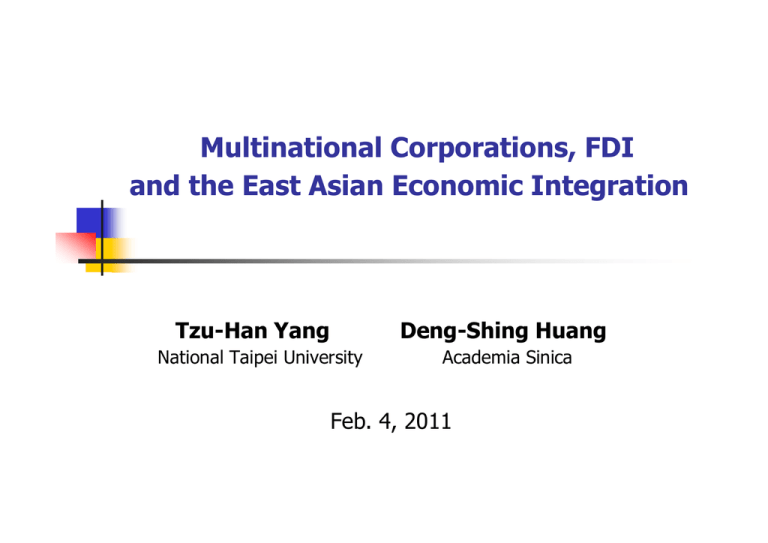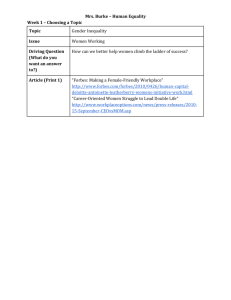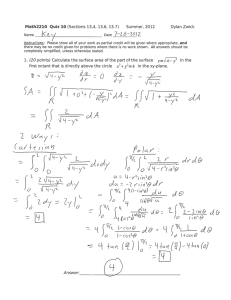Multinational Corporations, FDI and the East Asian Economic Integration Feb. 4, 2011
advertisement

Multinational Corporations, FDI and the East Asian Economic Integration Tzu-Han Yang Deng-Shing Huang National Taipei University Academia Sinica Feb. 4, 2011 Outline I. Multinational Corporations A. Why should we care about MNCs? B. Who have been investing abroad? C. What are they doing? D. MNC and FDI II. Foreign Direct Investment A. Examining gravity effect using clustering analysis B. FDI blocs and trade blocs III. The East Asian Economic Integration China’s catching up and flying geese paradigm IV. Conclusion 1 I. Multinational Corporations A. Why should we care about MNCs? 1. 2. 3. 53 of the top 100 economic bodies are MNCs. they are larger than ¾ of all nations in the world. (Gabel and Bruner 2003) Through FDI and trade, MNCs mobilize resources across countries, arrange vertical and horizontal production fragmentation, and form regional/global production networks. Willingly or not, national economies have been joined together and become dependent on one another. 2 B. Who have been investing abroad? Table 1. The ranking of the source countries of the Global 2000 firms source country 2009 2008 2007 2006 2004 2003 United States 1 ( 536) 1 ( 526) 1 ( 598) 1 ( 659) 1 ( 711) 1 (776) Japan 2 ( 270) 2 ( 290) 2 ( 259) 2 ( 291) 2 ( 326) 2 (331) China 3 ( 113) 3 ( 111) 4 ( 70) 9 ( 44) 17 ( 21) 21 (13) United Kingdom 4 ( 86) 4 ( 87) 3 ( 116) 3 ( 123) 3 ( 131) 3 (132) France 5 ( 64) 5 ( 66) 5 ( 67) 4 ( 66) 6 ( 61) 4 (67) Canada 6 ( 62) 7 ( 57) 6 ( 59) 5 ( 61) 4 ( 67) 7 (50) Germany 7 ( 57) 6 ( 62) 7 ( 59) 6 ( 57) 5 ( 63) 5 (64) India 8 ( 56) 8 ( 55) 10 ( 48) 15 ( 34) 15 ( 30) 16 (20) South Korea 9 ( 51) 9 ( 54) 8 ( 52) 7 ( 52) 8 ( 41) 6 (55) Hong Kong/China 10 ( 49) 10 ( 48) 12 ( 39) 8 ( 45) 12 ( 32) 13 (30) Taiwan 13 ( 39) 14 ( 40) 11 ( 42) 10 ( 42) 10 ( 35) 12 (32) Source: the Global 2000, the Forbes. Firm number in parentheses. 3 C. What are they doing? Table 2. Industrial distribution of the Global 2000 firms (average of all years) Finance Manufacturing Other services Resources type Transportation, communication & construction Industry Banking Diversified financing Insurance Capital goods Intermediate goods Consumption goods Market channels Production services Consumption services Material Oil and gas Utilities Transportation Communications Construction Source: the Global 2000, the Forbes. percentage (%) 15.44 28.71 7.90 5.36 7.62 22.93 6.44 8.87 6.47 18.88 6.22 6.19 6.20 17.82 5.76 5.86 4.16 11.70 3.48 4.06 4 Table 3. The ranking of the source countries of the finance firms in the Global 2000 (by firm number) source country 2009 2008 2007 2006 2004 United States 1 ( 117) 1 ( 110) 1 ( 135) 1 ( 159) 1 ( 160) Japan 2 ( 79) 2 ( 83) 2 ( 84) 2 ( 92) 2 ( 107) China 3 ( 28) 3 ( 28) 5 ( 22) 13 ( 13) 17 ( 8) India 4 ( 21) 4 ( 21) 7 ( 18) 12 ( 14) 13 ( 10) United Kingdom 5 ( 20) 6 ( 19) 3 ( 30) 3 ( 32) 4 ( 26) Italy 6 ( 18) 5 ( 20) 6 ( 18) 4 ( 22) 3 ( 26) Switzerland 7 ( 17) 10 ( 15) 11 ( 14) 8 ( 15) 6 ( 16) Hong Kong/China 8 ( 16) 11 ( 15) 9 ( 15) 6 ( 17) 10 ( 12) Australia 9 ( 16) 8 ( 16) 4 ( 23) 5 ( 18) 9 ( 14) Bermuda 10 ( 16) 7 ( 17) 14 ( 13) 11 ( 14) 15 ( 9) Canada 11 ( 15) 15 ( 13) 8 ( 15) 7 ( 16) 8 ( 14) France 12 ( 14) 12 ( 14) 13 ( 13) 16 ( 13) 11 ( 12) Taiwan 13 ( 14) 9 ( 15) 10 ( 15) 10 ( 14) 7 ( 15) Germany 14 ( 13) 14 ( 13) 15 ( 12) 14 ( 13) 5 ( 17) Spain 15 ( 12) 13 ( 13) 17 ( 9) 15 ( 13) 14 ( 9) South Korea 16 ( 11) 16 ( 11) 12 ( 14) 9 ( 15) 12 ( 10) United Arab Emirates 17 ( 9) 17 ( 9) 16 ( 10) ─** ─** Saudi Arabia 18 ( 8) 22 ( 7) 19 ( 7) 40 ( 2) ─** Sweden 19 ( 8) 19 ( 8) 23 ( 7) 18 ( 7) 16 ( 8) Greece 20 ( 7) 23 ( 6) 21 ( 7) 20 ( 7) 18 ( 7) Source: the Global 2000, the Forbes. Firm number in parentheses. 5 Table 4. The ranking of the source countries of the manufacturing firms in the Global 2000 (by firm number) Country 2009 2008 2007 2006 United States 1 ( 146) 1 ( 144) 1 ( 157) 1 ( 161) 1 ( 177) Japan 2 ( 85) 2 ( 98) 2 ( 79) 2 ( 90) 2 ( 95) China 3 ( 29) 3 ( 29) 9 ( 11) 11 ( 8) 23 ( 2) Taiwan 4 ( 20) 5 ( 21) 3 ( 22) 4 ( 20) 6 ( 15) Germany 5 ( 20) 4 ( 22) 4 ( 22) 5 ( 20) 3 ( 22) France 6 ( 19) 6 ( 20) 5 ( 22) 3 ( 21) 5 ( 20) Switzerland 7 ( 13) 7 ( 14) 7 ( 13) 8 ( 12) 8 ( 13) South Korea 8 ( 13) 8 ( 13) 8 ( 13) 7 ( 14) 7 ( 14) United Kingdom 9 ( 12) 9 ( 12) 6 ( 17) 6 ( 18) 4 ( 20) Sweden 10 ( 9) 10 ( 9) 10 ( 11) 9 ( 10) 10 ( 9) Hong Kong/China 11 ( 8) 11 ( 8) 37 ( 1) ─** Brazil 12 ( 7) 12 ( 7) 17 ( 4) 27 ( 2) 25 ( 2) Canada 13 ( 7) 15 ( 6) 11 ( 7) 10 ( 8) 9 ( 9) India 14 ( 6) 13 ( 6) 13 ( 5) 13 ( 5) 13 ( 5) Italy 15 ( 6) 14 ( 6) 14 ( 5) 14 ( 5) 14 ( 5) Saudi Arabia 16 ( 5) 17 ( 5) 25 ( 2) 29 ( 1) ─** Singapore 17 ( 5) 16 ( 5) 16 ( 4) 18 ( 3) 22 ( 2) Netherlands 18 ( 5) 21 ( 3) 12 ( 6) 12 ( 8) 11 ( 7) Mexico 19 ( 4) 20 ( 3) 23 ( 3) 17 ( 4) 12 ( 6) Australia 20 ( 4) 18 ( 4) 15 ( 4) 15 ( 4) 17 ( 4) Source: the Global 2000, the Forbes. 2004 ─** 6 Table 5. The ranking of the source countries of the other services firms in the Global 2000 (by firm number) Country 2009 2008 2007 2006 United States 1 ( 156) 1 ( 149) 1 ( 157) 1 ( 181) 1 ( 210) Japan 2 ( 41) 2 ( 42) 3 ( 36) 2 ( 45) 2 ( 55) United Kingdom 3 ( 27) 3 ( 28) 2 ( 39) 3 ( 41) 3 ( 45) France 4 ( 14) 4 ( 14) 4 ( 14) 4 ( 14) 4 ( 13) Canada 5 ( 11) 7 ( 10) 6 ( 11) 6 ( 10) 5 ( 12) Hong Kong/China 6 ( 11) 6 ( 11) 7 ( 9) 7 ( 10) 10 ( 5) South Korea 7 ( 10) 8 ( 10) 8 ( 9) 8 ( 8) 8 ( 6) Germany 8 ( 10) 5 ( 12) 5 ( 12) 5 ( 11) 6 ( 11) Australia 9 ( 7) 9 ( 7) 9 ( 8) 10 ( 6) 9 ( 5) India 10 ( 6) 11 ( 6) 11 ( 6) 12 ( 4) 18 ( 3) Mexico 11 ( 6) 13 ( 6) 12 ( 6) 11 ( 6) 11 ( 5) China 12 ( 6) 10 ( 6) 13 ( 4) 37 ( 1) --** Switzerland 13 ( 6) 12 ( 6) 21 ( 3) 14 ( 4) 12 ( 4) Ireland 14 ( 5) 17 ( 3) 29 ( 1) 21 ( 2) --** Brazil 15 ( 5) 16 ( 4) 24 ( 2) 34 ( 1) --** South Africa 16 ( 4) 15 ( 4) 14 ( 4) 13 ( 4) 13 ( 4) Netherlands 17 ( 4) 18 ( 3) 10 ( 7) 9 ( 7) 7 ( 11) Sweden 18 ( 4) 19 ( 3) 19 ( 3) 16 ( 3) 15 ( 3) Singapore 19 ( 4) 14 ( 4) 20 ( 3) 22 ( 2) 20 ( 2) Belgium 20 ( 3) 21 ( 3) 16 ( 3) 18 ( 3) 19 ( 2) Source: the Global 2000, the Forbes. 2004 7 Table 6. The rankings by firm number and sales, 2009 Source country Ranking by sales ($billions) The ranking by firm number United States 1 (8957.33) 1 ( 536) Japan 2 (4240.14) 2 ( 270) France 3 (2007.44) 5 ( 64) UK 4 (1921.80) 4 ( 86) Germany 5 (1771.44) 7 ( 57) China 6 (1308.44) 3 ( 113) Netherland 7 (851.97) 20 ( 22) South Korea 8 (842.54) 9 ( 51) Italy 9 (827.60) 14 ( 38) Switzerland 10 (714.54) 11 ( 48) Canada 11 (657.46) 6 ( 62) Spain 12 (566.91) 16 ( 29) Brazil 13 (476.27) 15 ( 33) Russia 14 (470.50) 17 ( 28) Australia 15 (458.51) 12 ( 44) India 16 (382.82) 8 ( 56) HK 17 (347.49) 10 ( 49) Taiwan 18 (341.76) 13 ( 39) Sweden 19 (275.66) 18 ( 27) Belgium 20 (258.43) 30 (12) Source: the Global 2000, the Forbes. 8 Fig. 1. The Herfindahl concentration index of the source countries of the Global 2000 firms Source: the Global 2000, the Forbes. 9 Table 7. Sales concentration ratio of the top 10 source countries—by industry Year all_firms finance manuf resource service tr_cm_ct 2004 0.855 0.850 0.927 0.815 0.942 0.845 2006 0.831 0.819 0.911 0.801 0.926 0.797 2007 0.802 0.789 0.896 0.763 0.920 0.772 2008 0.794 0.766 0.890 0.762 0.911 0.788 2009 0.778 0.749 0.873 0.759 0.900 0.771 Source: the Global 2000, the Forbes. D. MNC and FDI Table 7. The correlation coefficients between the firm number in the Global 2000 and FDI category MNC firm no. and inward FDI flow MNC firm no. and outward FDI flow MNC firm no. and inward FDI stock MNC firm no. and outward FDI stock 2009 2008 2007 2006 2004 2003 0.74 0.82 0.71 0.76 0.74 0.49 0.86 0.83 0.76 0.77 0.91 0.83 0.82 0.80 0.85 0.87 0.86 0.88 0.85 0.80 0.88 0.88 0.88 0.87 Source: 1. the Global 2000, the Forbes. 2. World investment Report, IMF, various years. 11 II. Foreign Direct Investment A. Examining Gravity effect using clustering analysis Figure 2: The tree diagram of total FDI blocs (2004) East Asia bloc Source: FTAP dataset, GTAP, Purdue University. We adopt the method of clustering analysis of Huang et al. 2006, J. of Economic Integration 21(3), 474-495 to see whether there is regional FDI blocs. 12 Figure 3: The tree diagram of manufacturing FDI blocs (2004) East Asia bloc Source: FTAP dataset, GTAP, Purdue University. 13 Figure 4: The tree diagram of trade blocs (2000) East Asia bloc By examining the evolution of bilateral trade density, we may find the development path of the economic integration through trade. 14 Figure 5: The tree diagram of trade blocs (2004) East Asia bloc In 2004, the inner core the East Asian trading bloc has changed from the pair of Japan and Taiwan in 2000 to the pair of Japan and China, followed by S. Korea and Taiwan. 15 Figure 6: The tree diagram of trade blocs (2008) East Asia bloc The structure remains in 2008. 16 III. The East Asian Economic Integration China’s catching up and flying geese paradigm The high density of Japan-China bilateral trade relationship may imply the sequence of flying geese pattern in the East Asia has changed. Does China catch up and pass over ASEANS? We calculate the RCA index for 742 SITC 4-digit industries to see how many and what industries that China inherited directly from Japan and NIEs and gained relative comparative advantages ahead of ASEANS. 17 III. The East Asian Economic Integration China’s catching up and flying geese paradigm RCA index Japan China Case 1: China inherits only from ASEAN4 time RCA index Japan China time Case 2: China inherits not only from ASEAN4 18 III. The East Asian Economic Integration China’s catching up and flying geese paradigm Indonesia Taiwan Japan Figure 8: RCA index for SITC 8465 19 III. The East Asian Economic Integration China’s catching up and flying geese paradigm Table 8. the number of industries that China inherited from various countries (1980-2002) Leading countries Japan/US US 100 NIEs ASEAN4 Japan Singapore Taiwan HK Korea Malaysia Thailand Philip. 118 118 128 100 122 73 96 74 Indo. 69 20 III. The East Asian Economic Integration China’s catching up and flying geese paradigm 4 3.5 CHINA 7519 3 HONG KONG 7519 2.5 INDONESIA 7519 KOREA REP. 7519 2 MALAYSIA 7519 PHILIPPINES 7519 1.5 SINGAPORE 7519 1 TAIWAN (POC) 7519 THAILAND 7519 0.5 0 RCA1999 RCA2000 RCA2001 RCA2002 RCA2003 RCA2004 RCA2005 RCA2006 RCA2007 RCA2008 Figure 8: RCA index for SITC (V3) 7519: office machines 21 III. The East Asian Economic Integration China’s catching up and flying geese paradigm 4 3.5 CHINA 7641 3 HONG KONG 7641 INDONESIA 7641 2.5 JAPAN 7641 2 KOREA REP. 7641 MALAYSIA 7641 1.5 PHILIPPINES 7641 1 SINGAPORE 7641 TAIWAN (POC) 7641 0.5 THAILAND 7641 0 RCA1999 RCA2000 RCA2001 RCA2002 RCA2003 RCA2004 RCA2005 RCA2006 RCA2007 RCA2008 Figure 8: RCA index for SITC (V3) 7641: electrical apparatus for line telephony or line telegraphy 22 Source: Hiratsuka (2005), The “Catching up” Process of Manufacturing in East Asia. Discussion paper of IDE, no. 22. No. of Goods in Each Ind. that China's Has Catched up before ASEAN4 25 20 計數 - item 15 10 5 0 1 2 3 4 5 7 8 9 10 11 12 13 14 15 16 17 18 19 20 22 23 24 25 26 27 28 29 30 31 33 35 36 41 42 Ratio of Item Per Ind, that China's Has Catched up before ASEAN4 100.00% 90.00% 80.00% 70.00% 60.00% Ratio 50.00% 40.00% 30.00% 20.00% 10.00% 0.00% 1 2 3 4 5 6 7 8 9 10 11 12 13 14 15 16 17 18 19 20 21 22 23 24 25 26 27 28 29 30 31 32 33 34 35 36 37 38 39 40 41 42 43 IV. Conclusion 1. 2. Large MNCs have grown rapidly in size of assets and sales and facilitated global and regional economic integration through FDI and intra- and inter-firm trade. East Asian countries have higher rankings in the manufacturing MNCs and have played a more important role in (regional) manufacturing production fragmentation. 26 IV. Conclusion 3. 4. 5. The countries with more large MNCs invest more abroad and receive more investment from abroad. There is (regional) gravity effect that the bilateral FDI intensity is high among Japan, NIEs and ASEANs, which may induce higher trade intensity in the EA region. The EA trading bloc structure change shows that China may have caught up and pass over the ASEAN4. 27 IV. Conclusion 6. The RCA index analysis results show that China inherited more industries directly from NIEs and Japan/US than from ASEAN4. Appendix 1: the top 10 firms of the Global 2000 (2009) Rank 1 2 3 4 5 6 7 8 8 10 Company JPMorgan Chase General Electric Bank of America ExxonMobil ICBC Banco Santander Wells Fargo HSBC Holdings Royal Dutch Shell BP Country US US US US China Spain US UK Netherlands UK Industry Sales ($bil) Profits ($bil) Assets ($bil) Market Vaue ($bil) Banking 115.63 11.65 2031.99 166.19 Conglomerates 156.78 11.03 781.82 169.65 Banking 150.45 6.28 2223.3 167.63 Oil & Gas Operations 275.56 19.28 233.32 308.77 Banking 71.86 16.27 1428.46 242.23 Banking 109.57 12.34 1438.68 107.12 Banking 98.64 12.28 1243.65 141.69 Banking 103.74 5.83 2355.83 178.27 Oil & Gas Operations 278.19 12.52 287.64 168.63 Oil & Gas Operations 239.27 16.58 235.45 167.13 Source: the Global 2000, the Forbes. Appendix 2: the top 10 manufacturing firms of the Global 2000 (2009) Rank Company 1 Procter & Gamble 2 Hewlett-Packard 3 Nestlé 4 Pfizer 5 Johnson & Johnson 6 Samsung Electronics 7 Sanofi-aventis 8 Ford Motor 9 Novartis 10 Roche Holding Country US US Switzerland US US S. Korea France US Switzerland Switzerland Industry Sales ($bil) Profits ($bil) Assets ($bil) Market Vaue ($bil) Household & Personal Products 76.78 13.05 135.29 184.47 Technology Hardware & Equip 116.92 8.13 113.62 121.33 Food, Drink & Tobacco 97.08 10.07 105.16 173.67 Drugs & Biotechnology 50.01 8.64 212.95 143.23 Drugs & Biotechnology 61.90 12.27 94.68 174.9 Semiconductors 97.28 4.43 83.30 94.48 Drugs & Biotechnology 41.99 7.54 114.85 98.07 Consumer Durables 118.31 2.72 194.85 41.80 Drugs & Biotechnology 44.27 8.40 90.89 126.22 Drugs & Biotechnology 47.35 7.51 69.64 146.19 Source: the Global 2000, the Forbes.






